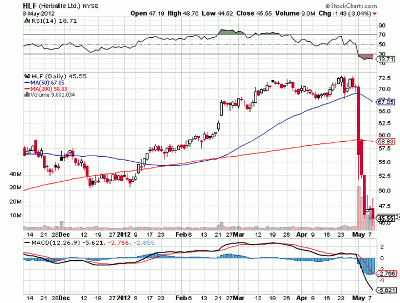On the heels of news that devastated shares of Herbalife (HLF), Karee Venema of Schaeffer’s Research reviews a credit spread that aims to profit from continued short-term weakness in the stock.
Options players have been accumulating calls on Herbalife Ltd. (HLF), per data from the International Securities Exchange and Chicago Board Options Exchange (CBOE). Over the course of the last five sessions, traders on these exchanges have bought to open 37,153 calls, as compared to 9,535 puts. HLF’s five-day call/put volume ratio is now docked at a call-heavy 3.90.
Expanding the scope, HLF’s 50-day call/put volume ratio of 3.39 ranks higher than 94% of other such readings taken in the past year. In other words, calls have been bought to open over puts at a near annual-high pace in recent months.
This trend toward calls is being continued in a recent session, as well. Calls and puts were trading at 1.9 times and two times their average intraday volumes, respectively, but the former are easily beating the latter in the numbers game. Roughly 15,000 call contracts had crossed the tape, as opposed to around 9,650 put contracts.
One neutral-to-bearish player is using some of these calls to construct a short call spread, or credit spread, in the front-month series. One block of 199 May 55 calls crossed the tape near the ask price at $0.96, while a symmetrical block of 199 May 50 calls changed hands near the bid price at $1.96, establishing a net credit of $1. This is also the maximum potential reward for the play, should HLF remain south of $50 through May expiration, allowing both legs to expire worthless.
Conversely, the maximum potential loss is limited to $4, or the difference between the two strikes minus the net credit received.
See also: Understanding Debit and Credit Spreads
On a technical basis, HLF has one ugly chart. It took a 33% dive last week following hedge fund manager David Einhorn’s recent line of questioning during the company’s first-quarter conference call.
The equity is now staring at a 9.2% year-to-date deficit. The stock is continuing to tread in annual-low territory, tagging a new 52-week nadir in recent sessions. This came just two weeks after hitting its all-time high of $73.
By Karee Venema of Schaeffer’s Research



















